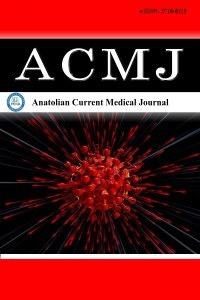The usability of shock index and lactate in predicting mortality in multitrauma patients presenting to the emergency department
The usability of shock index and lactate in predicting mortality in multitrauma patients presenting to the emergency department
Multitrauma, Shock index, Lactate Emergency department, Mortality,
___
- Jin WYY, Jeong JH, Kim DH, et al. Factors predicting the early mortality of trauma patients. Ulusal Travma Ve Acil Cerrahi Dergisi-Turkish Journal of Trauma & Emergency Surgery 2018; 24: 532-8.
- Balhara KS, Hsieh Y-H, Hamade B, Circh R, Kelen GD, Bayram JD. Clinical metrics in emergency medicine: the shock index and the probability of hospital admission and inpatient mortality. Emergency Medicine Journal 2017; 34: 89-94.
- McNab A, Burns B, Bhullar I, Chesire D, Kerwin A. A prehospital shock index for trauma correlates with measures of hospital resource use and mortality. Surgery 2012; 152: 473-6.
- McNab A, Burns B, Bhullar I, Chesire D, Kerwin A. An analysis of shock index as a correlate for outcomes in trauma by age group. Surgery 2013; 154: 384-7.
- Singh A, Ali S, Agarwal A, Srivastava RN. Correlation of shock index and modified shock index with the outcome of adult trauma patients: a prospective study of 9860 patients. North American journal of medical sciences 2014; 6: 450-2.
- Mutschler M, Nienaber U, Muenzberg M, et al. The Shock Index revisited—a fast guide to transfusion requirement? A retrospective analysis on 21,853 patients derived from the TraumaRegister DGU (R). Critical Care 2013; 17.
- Jansen TC, van Bommel J, Schoonderbeek FJ, et al. Early lactate-guided therapy in intensive care unit patients: a multicenter, open-label, randomized controlled trial. Am J Respir Crit Care Med 2010; 182: 752-61.
- Kjelland CB, Djogovic D. The role of serum lactate in the acute care setting. J Intensive Care Med 2010; 25: 286-300.
- Uzoigwe CE, Venkatesan M, Smith R, et al. Serum lactate is a prognostic indicator in patients with hip fracture. Hip Int 2012; 22: 580-4.
- Dübendorfer C, Billeter AT, Seifert B, Keel M, Turina M. Serial lactate and admission SOFA scores in trauma: an analysis of predictive value in 724 patients with and without traumatic brain injury. Eur J Trauma Emerg Surg 2013; 39: 25-34.
- Régnier MA, Raux M, Le Manach Y, et al. Prognostic significance of blood lactate and lactate clearance in trauma patients. Anesthesiology 2012; 117: 1276-88.
- Mitra B, Fitzgerald M, Chan J. The utility of a shock index > = 1 as an indication for pre-hospital oxygen carrier administration in major trauma. Injury-International Journal of the Care of the Injured 2014; 45: 61-5.
- Cortés-Samacá CA, Meléndez-Flórez HJ, Álvarez Robles S, Meléndez-Gómez EA, Puche-Cogollo CA, Mayorga-Anaya HJ. Base deficit, lactate clearance, and shock index as predictors of morbidity and mortality in multiple-trauma patients. Revista Colombiana de Anestesiología 2018; 46: 208-15.
- Sloan EP, Koenigsberg M, Clark JM, Weir WB, Philbin N. Shock index and prediction of traumatic hemorrhagic shock 28-day mortality: data from the DCLHb resuscitation clinical trials. The western journal of emergency medicine 2014; 15: 795-802.
- Charry JD, Bermeo JM, Montoya KF, Calle-Toro JS, Núñez LR, Poveda G. Shock index as predictor of mortality in patients with penetrating trauma of the thorax Índice de shock como factor predictor de mortalidad en el paciente con trauma penetrante de tórax. Revista Colombiana de Cirugía 2015; 30: 24-8.
- Claridge JA, Crabtree TD, Pelletier SJ, Butler K, Sawyer RG, Young JS. Persistent occult hypoperfusion is associated with a significant increase in infection rate and mortality in major trauma patients. J Trauma 2000; 48: 8-14
- Bakker J, Gris P, Coffernils M, Kahn RJ, Vincent JL. Serial blood lactate levels can predict the development of multiple organ failure following septic shock. Am J Surg.1996; 171: 221-6
- Rixen D, Raum M, Holzgraefe B, Sauerland S, Nagelschmidt M, Neugebauer EA. Shock and Trauma Study Group. A pig hemorrhagic shock model: Oxygen debt and metabolic acidemia as indicators of severity. Shock 2001; 16: 239-44
- Hobbs TR, O’Malley JP, Khouangsathiene S, Dubay CJ. Comparison of lactate, base excess, bicarbonate, and pH as predictors of mortality after severe trauma in rhesus macaques (Macaca mulatta). Comp Med 2010; 60: 233-9
- Revelly JP, Tappy L, Martinez A, et al. Lactate and glucose metabolism in severe sepsis and cardiogenic shock. Crit Care Med 2005; 33: 2235-40
- Dunne JR, Tracy JK, Scalea TM, Napolitano LM. Lactate and base deficit in trauma: Does alcohol or drug use impair their predictive accuracy? J Trauma 2005; 58: 959-66
- Yayın Aralığı: 6
- Başlangıç: 2019
- Yayıncı: MediHealth Academy Yayıncılık
Semih BAŞKAN, Musa ZENGİN, Murat AKÇAY, Feryal KORKMAZ AKÇAY, Erman CEYHAN, Ali ALAGÖZ
Figen PEHLİVANOĞLU, Mehtap TUNÇ, Hilal SAZAK, Polat PEHLİVANOĞLU, Musa ZENGİN, Ali ALAGÖZ
Prognostic significance of controlling nutritional status (CONUT) score in hemodialysis patients
Fatma YILMAZ AYDIN, Enver YÜKSEL, Emre AYDIN
Ferhat ÇAY, Hasan Basri ÇETİNKAYA
Changing profile of infective endocarditis during 31-year time course in a tertiary care hospital
Ali Erkan DUMAN, Yesim CETİNKAYA SARDAN
Assessment of failed spinal anesthesia for cesarean section during COVID-19 pandemic
Ali Doğan DURSUN, Samet UÇAK, Orhan YAVUZ, Mediha Nur Zafer YURT, Behiye Büşra TAŞBAŞI, Elif Esma ACAR, Veli Cengiz ÖZALP, Mert SUDAĞIDAN
Hamide Ayben KORKMAZ, Ahmet KARAOĞLU, İlkay CEYLAN
Orbital MRI in thyroid-associated orbitopathy
Muhammed Akif DENİZ, Mehmet TURMAK, Zafer PEKKOLAY, Salih HATTAPOĞLU
